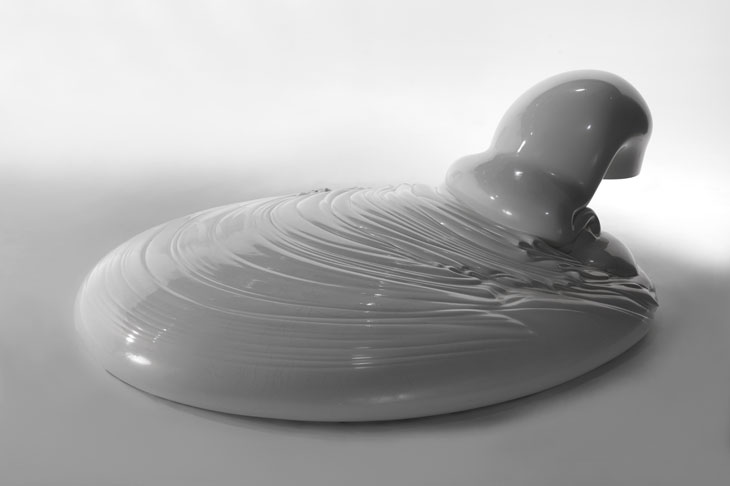‘In the artistic context of 1960, at the moment when so many allegedly avant-garde styles and languages are wearing themselves out, César’s art takes on capital importance: he proposes a new method of capturing reality.’ So declared Pierre Restany, art critic and founder in 1960 of the avant-garde movement Nouveau Réalisme, of which César was a member alongside others including Yves Klein, Arman and Niki de Saint Phalle. For Restany, the essence of Nouveau Réalisme was the act of appropriation as a way of merging art and life: the direct presentation of objects and materials drawn from the everyday. But the Centre Pompidou’s current retrospective of César’s work, the first survey devoted to the artist since his death 20 years ago, speaks less of a sculptor who eradicated history in favour of the now and the ‘new’ than of one whose art progressed in thematic cycles, past and present in constant dialogue. And, as the exhibition makes clear, César had achieved remarkable success with expressionist sculpture before joining the Nouveau Réalistes, and went on to establish a reputation as one of Europe’s most innovative sculptors long after the group dispersed in 1963.
Chauve-souris (1954), César. MNAM/Centre Pompidou, Paris. Photo: © Centre Pompidou, MNAM-CCI/Dist. RMN-GP; © SBJ/Adagp, Paris 2017
The Pompidou exhibition is staged in a single vast, open-plan gallery. It begins in 1947, four years after César (born Cesare Baldaccini) moved to Paris from his hometown of Marseille, with a presentation of his welded iron pieces, redolent of assemblages by Picasso, Giacometti and Germaine Richier, and ends in 1998 with the dazzling colours and cubic configuration of his Suite Milanaise. César’s intense awareness of metal and his control of its properties is clear from his early works. While archaic in their rusted tones and forms recalling fantastical creatures or legends of the past, they also embody, in the words of art historian Douglas Cooper, ‘a robotic air’. The arrangement of L’homme qui marche (1954), Le Chauve-souris (1955) and Personnage assis (1955) particularly stands out, exemplifying a conception of sculpture that plays with gravity and instability.
It was around the same time, in the mid 1950s, that César began to combine elements of scrap iron with car parts. His compacted metal bales bear witness to the torsion, compression and amalgamation he saw in a factory in the suburbs of Paris. The pieces are far from the straightforward celebrations of the modern everyday that Restany had described. Rather, they act to deflate the euphoria of a growing consumer society, revealing the poetic dimension of the found object. They are also important precursors to César’s monumental Compressions, seven of which are presented close by in one of the highlights of the exhibition. Dating from 1960–62, these abandoned car carcasses, compressed into metal parallelepipeds by a hydraulic press in Gennevilliers and permeated with creases and crevasses, speak not only of the economics of space, but of their own chromatic potential to capture light and play with reflection.
Compression: Yellow Buick (1961), César. The Museum of Modern Art, New York. Photo: © 2017, Museum of Modern Art, New York/Scala, Florence
As the exhibition progresses, so too does it document César’s evolving appreciation for different materials, moving from metal to the metamorphic power of other, newer substances. Discovering polyurethane foam at the beginning of 1967, he would pour the swelling mixture, often in public, controlling its direction and general shape. The Expansions, as the resulting forms are called, are complemented by the lesser-known Envelopments, a Duchampian series of pieces from 1970–72 in which everyday objects are wrapped in transparent sheets of melted plastic. Together with works such as Sein (1967) and Pouce (1965), excellent examples of his innovative method of moulding body parts, César’s synthetic sculptures give a clear sense of his interest in the array of possibilities offered by these new materials.
César and Sein (1967) at the Schneider Foundry in Montchanin (France), 1967. Photo: © Georges Kelaidites Fonds J.B. Gillot/adoc-photos
Although many major sculptures are included, there are some gaps in the exhibition: namely, the artist’s plastic variations on the Compressions begun in 1971, and his collaboration with the crystal studio Daum, which culminated in a collection of smaller, compressed crystal pieces presented at the Musée des Arts Décoratifs in 1969. Despite this, the exhibition does a great deal to deepen understanding of the artist and his work. Extensive captions elucidate relevant biographical details, while the presentation of archival film footage explores the performative nature of César’s sculptural methods. And curator Bernard Blistène has carefully navigated the cyclical terrain of the artist’s fifty-year career, as the final parts of the exhibition successfully demonstrate, displaying Expansions that he returned to and cast in iron in the early 1990s alongside the Championnes, a series of flattened automobiles presented in vertical configuration recalling the planar surfaces of the Plaques of the early 1960s. This retrospective, then, presents an intelligent portrait of César as an artist who played with notions of return and repetition, and was ultimately governed by the logic of materials.
‘César’ is at the Centre Pompidou, Paris, until 26 March.
